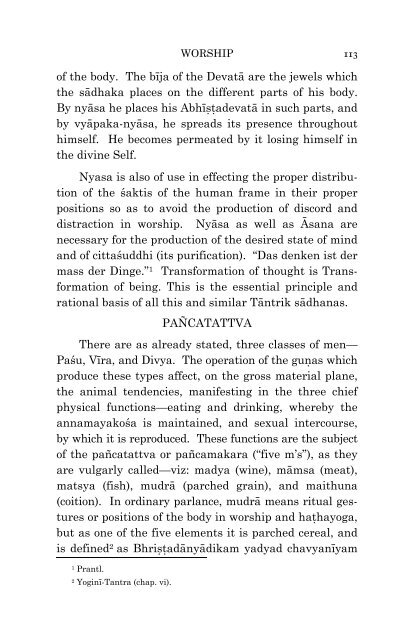Introduction to Tantra Sastra - Aghori
Introduction to Tantra Sastra - Aghori
Introduction to Tantra Sastra - Aghori
You also want an ePaper? Increase the reach of your titles
YUMPU automatically turns print PDFs into web optimized ePapers that Google loves.
WORSHIP 113<br />
of the body. The bīja of the Devatā are the jewels which<br />
the sādhaka places on the different parts of his body.<br />
By nyāsa he places his Abhīṣṭ adevatā in such parts, and<br />
by vyāpaka-nyāsa, he spreads its presence throughout<br />
himself. He becomes permeated by it losing himself in<br />
the divine Self.<br />
Nyasa is also of use in effecting the proper distribution<br />
of the śaktis of the human frame in their proper<br />
positions so as <strong>to</strong> avoid the production of discord and<br />
distraction in worship. Nyāsa as well as Āsana are<br />
necessary for the production of the desired state of mind<br />
and of cittaśuddhi (its purification). “Das denken ist der<br />
mass der Dinge.” 1 Transformation of thought is Transformation<br />
of being. This is the essential principle and<br />
rational basis of all this and similar Tāntrik sādhanas.<br />
PAÑCATATTVA<br />
There are as already stated, three classes of men—<br />
Paśu, Vīra, and Divya. The operation of the guṇ as which<br />
produce these types affect, on the gross material plane,<br />
the animal tendencies, manifesting in the three chief<br />
physical functions—eating and drinking, whereby the<br />
annamayakośa is maintained, and sexual intercourse,<br />
by which it is reproduced. These functions are the subject<br />
of the pañcatattva or pañcamakara (“five m’s”), as they<br />
are vulgarly called—viz: madya (wine), māmsa (meat),<br />
matsya (fish), mudrā (parched grain), and maithuna<br />
(coition). In ordinary parlance, mudrā means ritual gestures<br />
or positions of the body in worship and haṭ hayoga,<br />
but as one of the five elements it is parched cereal, and<br />
is defined 2 as Bhriṣṭ adānyādikam yadyad chavyanīyam<br />
1 Prantl.<br />
2 Yoginī-<strong>Tantra</strong> (chap. vi).

















